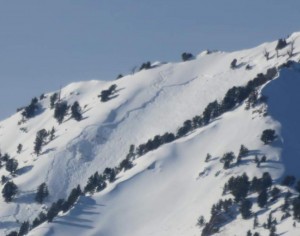In the aftermath of a recent rash of avalanche deaths, in particular the latest fatality in Utah involving a skier who wore and deployed an airbag yet died anyway, it bears repeating that when it comes to avoiding becoming an avalanche statistic, caution is the better part of valor. The fatality occured on Gobbler’s Knob, in the Wasatch mountains. Not only was the victim using an airbag pack, he was with Tyson Bradley, an experienced mountain guide. Tyson has been guiding in Utah for over two decades, with climbing and ski mountaineering experience around the world. Yet all this knowledge and preparedness does not make anyone all knowing or immune from making a bad call.Terrain consequences are extremely important. If the avalanche we may trigger will take us over a cliff, into trees, down a very large avalanche path, or into a terrain trap, then we have a low chance of survival, despite whatever rescue gear we may carry.
— Bruce Tremper
In this particular incident Tyson led the way down the E face of Gobbler’s Knob, then pulled off to the side in a safe zone. That detail indicates that Tyson and the victim both knew the line they were skiing had the potential to slide. This should not be taken as a damning observation, rather, an acknowledgment that the best skiing is often found on the edge of a slope capable of avalanching, but not actually doing so. In other words, the more exhilarating the ski descent, the closer the conditions are to causing or being caught in an avalanche. YMMV.
The “safe” line is the one that allows a margin of safety away from that line, but the “fun” line goes right to the edge, and hopefully, doesn’t cross it. What’s the difference? In some cases it is using knowledge of terrain and conditions to avoid getting too close to the danger line. However, as this latest incident highlights, there is also a degree of luck involved.
As Bruce Tremper points out in his latest post on the Utah Avalanche Center’s blog, avalanche airbag packs are not as effective as we’ve been led to believe. Statistics claiming a 97% survival rate are evidence of a company using numbers to promote their product. Indeed, airbags do improve your chances of survival, but those statistics were derived to enhance the value of the product. As Tremper points out, when an independent study was conducted the numbers still said airbag packs helped save lives, but the save rate was less than half the number claimed. When boiled down, Tremper says the save rate is more like 41%.
In the end, the most important tool you have to avoid avalanches, aside from staying home, it to consider the consequences of being caught and chose terrain and conditions that, with a dash of luck, simply avoid them.
With a rash of avalanche fatalities in the past week it bears repeating to be careful out there.
Related Posts:
SLC man killed in Utah’s first fatal avalanche of the season
One man killed, another injured in Gobbler’s Knob avalanche
© 2016


Recent Comments